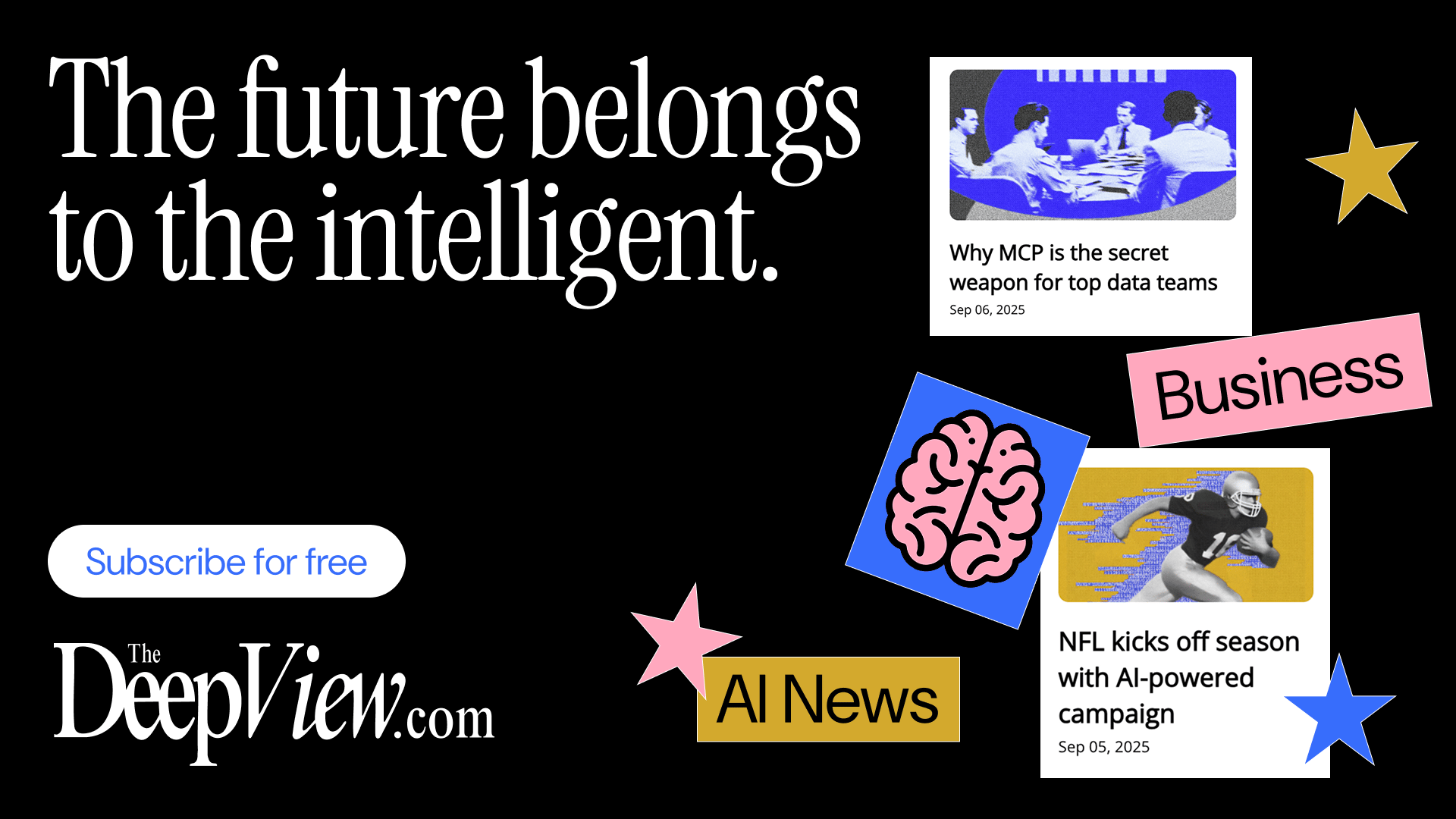- Enterprise AI Daily
- Posts
- AI Adoption Whiplash, Microsoft's Bundle Play, and the $38B Power Bet
AI Adoption Whiplash, Microsoft's Bundle Play, and the $38B Power Bet
When every data point tells a different story, enterprise leaders need a better compass

Today we're tackling the most maddening phenomenon in AI right now: adoption whiplash. One day the headlines scream that AI is everywhere, the next we're told nobody's actually using it. Meanwhile, Microsoft just launched a new consumer bundle that might tell us more about enterprise pricing than you'd think, Google's playing an inconsistent game with AI search results on sensitive topics, and BlackRock is betting $38 billion that the real AI gold rush is in keeping the lights on.
Let’s dig in.
The AI Insights Every Decision Maker Needs
You control budgets, manage pipelines, and make decisions, but you still have trouble keeping up with everything going on in AI. If that sounds like you, don’t worry, you’re not alone – and The Deep View is here to help.
This free, 5-minute-long daily newsletter covers everything you need to know about AI. The biggest developments, the most pressing issues, and how companies from Google and Meta to the hottest startups are using it to reshape their businesses… it’s all broken down for you each and every morning into easy-to-digest snippets.
If you want to up your AI knowledge and stay on the forefront of the industry, you can subscribe to The Deep View right here (it’s free!).
Schrödinger’s AI Adoption: Everyone's Using It, Nobody's Using It, and We're All Confused
Here's the situation that's driving us slightly insane: according to new Pew Research data, only 9% of Americans say they get news from AI chatbots often or sometimes, with 75% saying they never use them for news at all. And yet, we keep seeing reports about explosive ChatGPT growth, enterprise adoption surging, and AI becoming "inevitable."
So which is it? Are we living in an AI revolution or is this just another overhyped cycle that'll fizzle out like Google Glass?
The answer, frustratingly, is both. And understanding why requires ditching the binary thinking that plagues most AI coverage.
First, the context matters. Pew’s survey shows that among people who do use chatbots for news, their experiences are mixed at best: a third find it difficult to determine what's true, and about half say they sometimes encounter inaccurate information. Younger users are particularly skeptical, with 59% of adults ages 18-29 reporting they see inaccurate news from AI chatbots at least sometimes.
Second, what they’re asking also matters.
“Use” might mean asking ChatGPT a question once a month, or running your finance function on a fine-tuned LLM. Same label, wildly different stakes.
Consumer vs. enterprise adoption are on different timelines. Consumers might still prefer TikTok or cable news over a chatbot, but enterprise IT teams are rolling out copilots across 300,000 seats.
Survey framing matters. Ask “Do you get your news from AI?” and most people will say no. Ask “Have you used AI to summarize or search for information?” and suddenly the numbers spike.
For leaders leaders, this data reveals something critical about the adoption curve you're actually dealing with. Here’s the throughline that actually matters:
Use case specificity is everything.
Consumer adoption lags, enterprise adoption leads. People still get news from people. But enterprises are plugging AI into workflows at scale, because it shaves costs and unlocks productivity.The trust gap is segmenting.
When 42% of chatbot news users aren't sure whether they can determine what's true, we're looking at a fundamental adoption barrier that won't disappear with better models. This should inform how you roll out AI tools internally. High-stakes, trust-dependent workflows need human verification layers, period.Demographics aren't predictive anymore.
Traditional tech adoption followed a clear age curve. AI is different. Younger users are more likely to use chatbots but also more likely to distrust their output. That means your digital-native workforce isn't automatically your AI-forward workforce. Training and change management need to account for sophisticated skepticism.The metrics gap is real. Here's the part that explains your whiplash: different surveys measure wildly different things. ChatGPT user counts measure anyone who's tried it once. Active use surveys show much lower adoption. Task-specific deployment data shows high effectiveness. They're all true, and they all tell different stories. For your board presentations, this means choosing your metrics carefully and always specifying what you're measuring.
The long arc we’re betting on: enterprises set the foundation, consumer behaviors follow. Remember when “streaming” sounded like a niche tech word until Netflix ate Blockbuster alive? Same trajectory.
So yes, the headlines are contradictory. That’s because AI is both underused and overhyped, depending on where you look. The key for enterprises: the companies winning at AI implementation won’t be the ones deploying it everywhere. They'll be the ones being ruthlessly selective about where it makes sense.

Enterprise AI Daily Briefing // Created with Midjourney
AI News
Microsoft launches 365 Premium with AI Copilot baked in
For $19.99/month, users get AI copilot across Word, Excel, Outlook, and more. They appear to be testing whether bundling drives more usage than standalone AI products. Enterprise teams watching this rollout should note the pricing pressure building in the consumer market, which typically precedes similar dynamics in enterprise negotiations.
Read more →Google blocks political AI queries in search
Google is blocking AI-generated summaries for searches about Trump's mental health, showing "AI Overview not available" messages, while providing AI summaries for similar queries about other political figures. The inconsistency has sparked questions about how platforms moderate sensitive political content.
Read more →BlackRock eyes $38B deal for AES
The deal comes as BlackRock CEO Larry Fink forecasts global infrastructure investment demand of $68 trillion by 2040, with data center buildout as a major driver. For enterprise leaders, this underscores what the smart money knows: the real AI infrastructure bottleneck isn't compute or data, it's reliable power at scale.
Read more →
CTV ads made easy: Black Friday edition
As with any digital ad campaign, the important thing is to reach streaming audiences who will convert. Roku’s self-service Ads Manager stands ready with powerful segmentation and targeting — plus creative upscaling tools that transform existing assets into CTV-ready video ads. Bonus: we’re gifting you $5K in ad credits when you spend your first $5K on Roku Ads Manager. Just sign up and use code GET5K. Terms apply.
TL;DR:
AI adoption looks contradictory because consumer vs. enterprise usage are on different timelines.
Pew says few Americans use chatbots for news, but enterprises are deploying AI at scale where it counts.
Microsoft just made “AI Copilot” a paid subscription norm.
Google is tightening AI guardrails on election queries.
BlackRock may drop $38B to secure the electricity AI will need.
A Final Thought
The AI adoption paradox isn't going away. Every week will see new data that seems to contradict last week's narrative. The companies that win won't be the ones who wait for consensus. They'll be the ones who understand that "AI adoption" is too broad a category to be useful, and who focus instead on the specific intersections of use case, trust, and value that work for their unique operations.
Stay sharp,
Cat Valverde
Founder, Enterprise AI Solutions
Navigating Tomorrow's Tech Landscape Together


